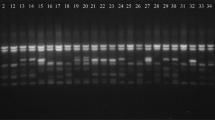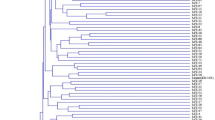Abstract
Random samples, consisting of at least 100 individual seedlings, were taken from the diploid (2n=2x=36) eastern gamagrass (Tripsacum dactyloides var.dactyloides) and assayed to determine which of 12 enzyme marker loci and isozyme systems would be most informative in providing satisfactory resolution of both maize andTripsacum isozyme systems. For comparison, eight maize inbreds were included in the study to aid evaluation and comparison of the various isozyme systems. In addition, evaluations were conducted to identify if the identified optimum isozyme system could be used to detectTripsacum introgression in maize following a maize ×Tripsacum backcrossing scheme. Using the established isozyme techniques for maize (Zea mays L.), theAdh, Pgd, Cat, Est, B-Glu, Got, Idh, Tpi isozyme systems detected no polymorphism among theTripsacum individuals assayed. TheEst andB-Glu systems forTripsacum were unscorable due to poor staining and resolution. TheAcp, Mdh, Pgm, andPhi isozyme systems were found to be satisfactory markers for differentiating between eastern gamagrass individuals as well as detectingTripsacum introgression in maize. The availability of useful isozyme systems which can simultaneously provide significant isozyme resolution of maize,Tripsacum and maize-Tripsacum backcross hybrids, on a single gel system, will be useful for the detection of marker assistedTripsacum introgression into maize. In addition, the identification of a set of variable biochemical markers should also assist breeding, selection and genetic manipulations in eastern gamagrass.
Similar content being viewed by others
References
Ahring, R.M. & H. Frank, 1968. Establishment of eastern gamagrass from seed and vegetative propagation. J. Range Manage 21: 27–30.
Berg, W.A., C.L. Dewald & P.L. Sims, 1994. Complementary grazing of eastern gamagrass and Old World bluestem. p. 39–40. Eastern Gamagrass Workshop Proceedings, Manhattan, KS. Vol. 4, Oct. 13–14.
Brown, W.V. & W.H.P. Emery, 1958. apomixis in the Gramineae: Panicoideae. Am. J. Bot. 45: 253–263.
Burns, J.C., D.S. Fisher, K.R. Pond & D.H. Timothy, 1992. Diet characteristics, digesta, kinetics, and dry matter intake of steers grazing eastern gamagrass. J. Anim. Sci. 70: 1251–1261.
Burson, B.L., P.W. Voigt, R.A. Sherman & C.L. Dewald, 1990. Apomixis and sexuality in eastern gamagrass. Crop Sci. 30: 86–89.
Cutler, H.C. & E.G. Anderson, 1941. A preliminary survey of the genusTripsacum. Ann. Mo. Bot. Gard. 28: 249–269.
deWet, J.M.J., D.H. Timothy, K.W. Hilu & G.B. Fletcher, 1981. Systematics of South American Tripsacum (Gramineae). Am. J. Bot. 68: 269–276.
deWet, J.M.J., J.R. Harlan & D.E. Brink, 1982. Systematics ofTripsacum dactyloides (Gramineae). Am. J. Bot. 69: 1251–1257.
Farquharson, L.I., 1954. Natural selection of tetraploids in a mixed colony ofTripsacum dactyloides. Proc. Indiana Acad. Sci. 63: 80–82.
Fine, G.L., F.L. Barnett, K.L. Anderson, R.D. Lippert & E.T. Jacobson, 1990. Registration of ‘Pete’ eastern gamagrass. Crop Sci. 30: 741–742.
Galinat, W.C., R.S.K. Chaganti & F.D. Hager, 1964. Tripsacum as a possible amphidiploid of wild maize and manisuris. Botanical Museum Leaflets, Harvard University, 20: 289–316.
Galinat, W.C., 1973. Intergenomic mapping of maize, teosinte, andTripsacum. Evolution 27: 644–655.
Kindiger, B. & J.B. Beckett. 1992. Popcorn germplasm as a parental source for maize ×Tripsacum dactyloides hybridization. Maydica 37: 245–249.
Kindiger, B., 1994. A method to enhance germination of eastern gamagrass. Maydica 39: (in press).
Stuber, C.W., J.F. Wendel, M.M. Goodman & J.S.C. Smith, 1988. Techniques and scoring procedures for starch gel electrophoresis of enzymes from maize (Zea mays L.). Technical Bull. 286, North Carolina Agric. Res. Serv., North Carolina State University, Raleigh, NC.
Author information
Authors and Affiliations
Additional information
The use of company names in this publication does not imply endorsement by the USDA-ARS, or the product names of criticism of similar ones not mentioned. All programs and services of the U.S. Department of Agriculture are offered on a nondiscriminatory basis without regard to race, color, national origin, religion, sex, age, marital status, or handicap.
Rights and permissions
About this article
Cite this article
Kindiger, B., Vierling, R.A. Comparative isozyme polymorphisms of north American eastern gamagrass,Tripsacum dactyloides var.dactyloides and maize,Zea mays L.. Genetica 94, 77–83 (1994). https://doi.org/10.1007/BF01429223
Received:
Accepted:
Issue Date:
DOI: https://doi.org/10.1007/BF01429223




